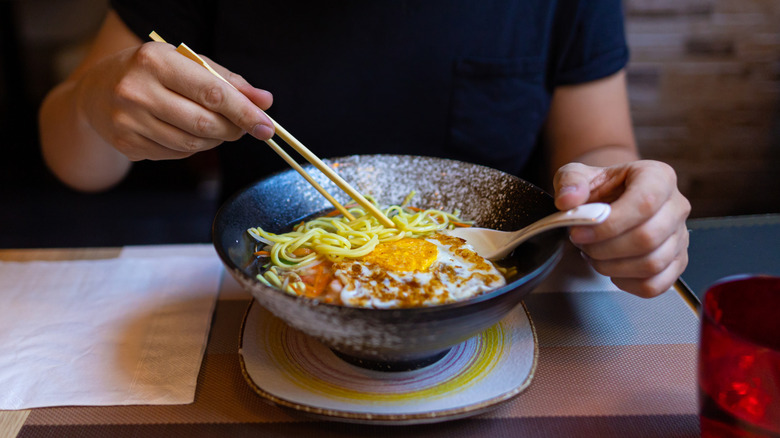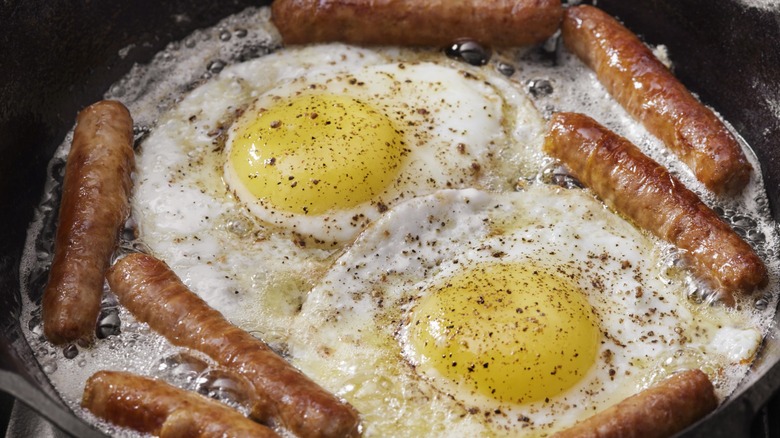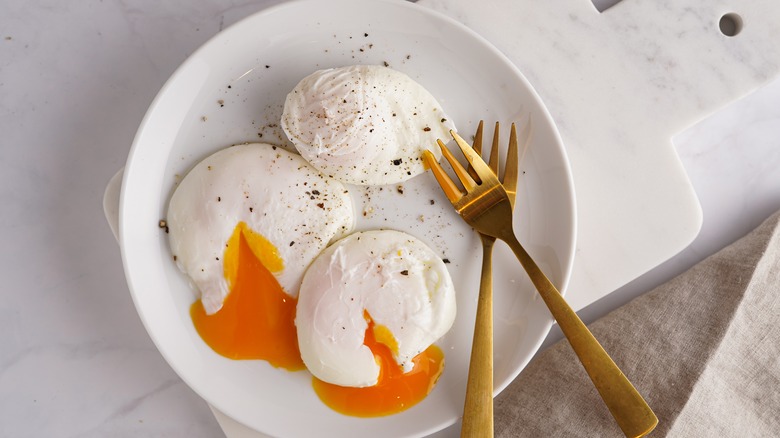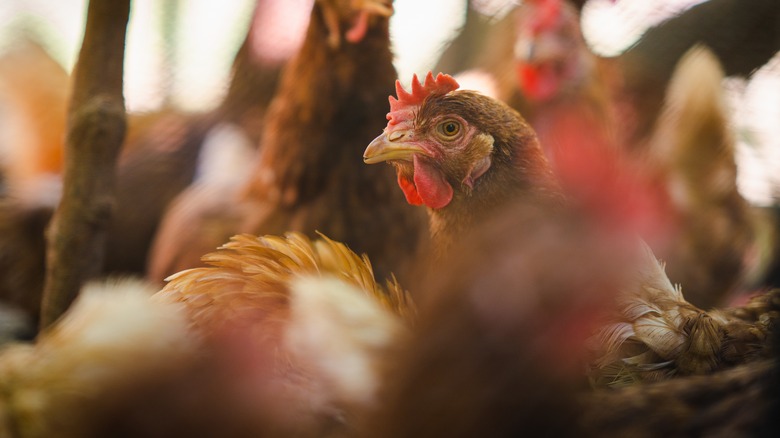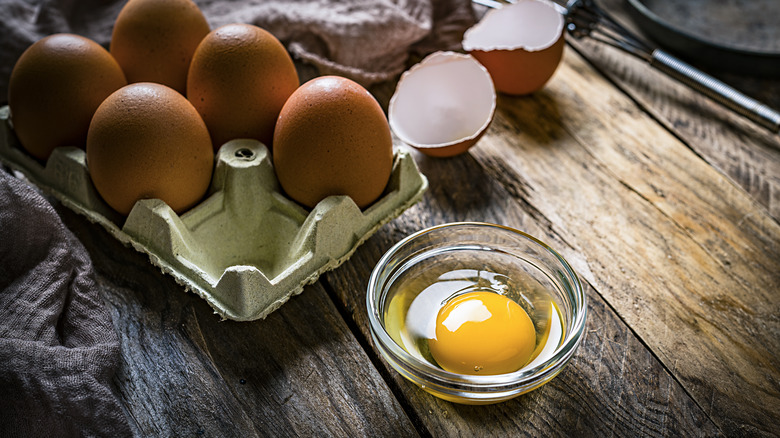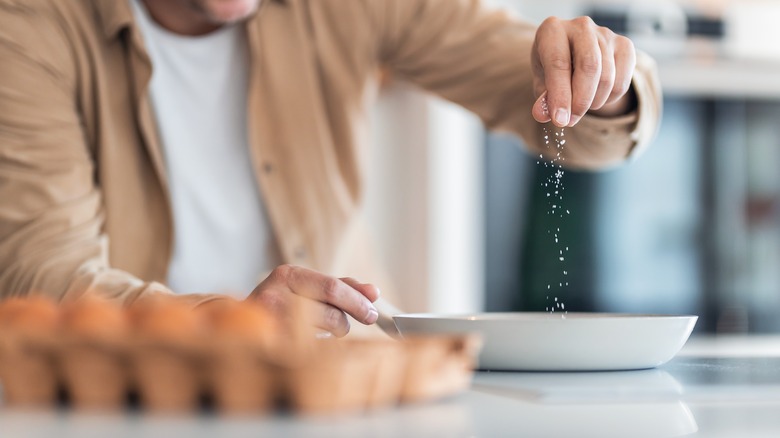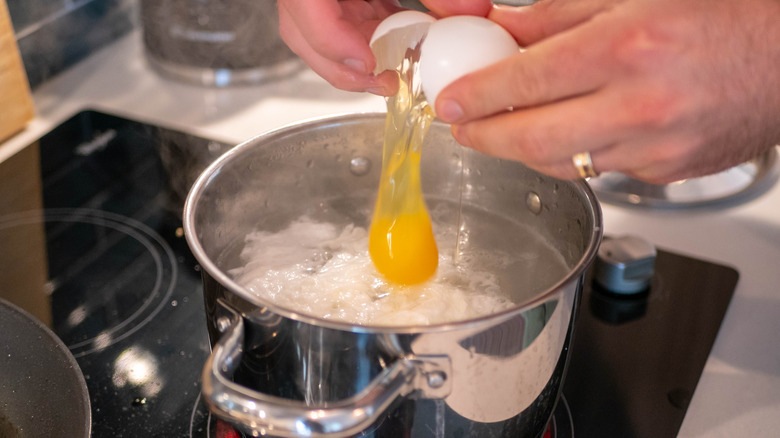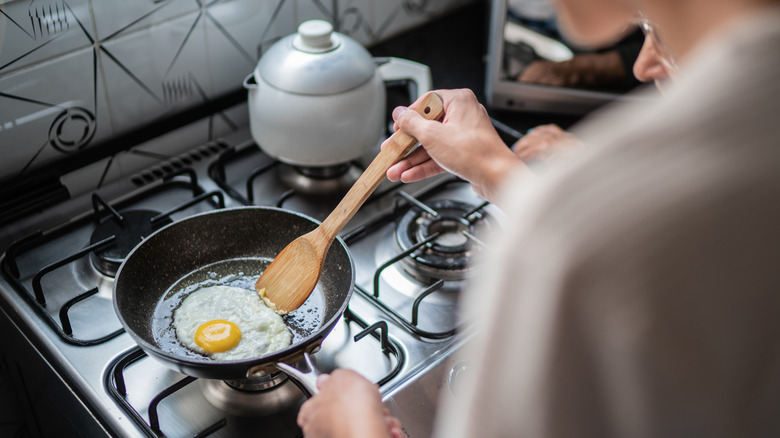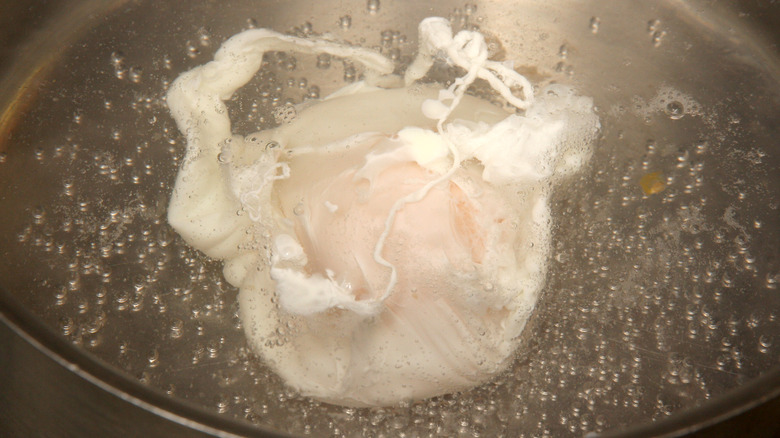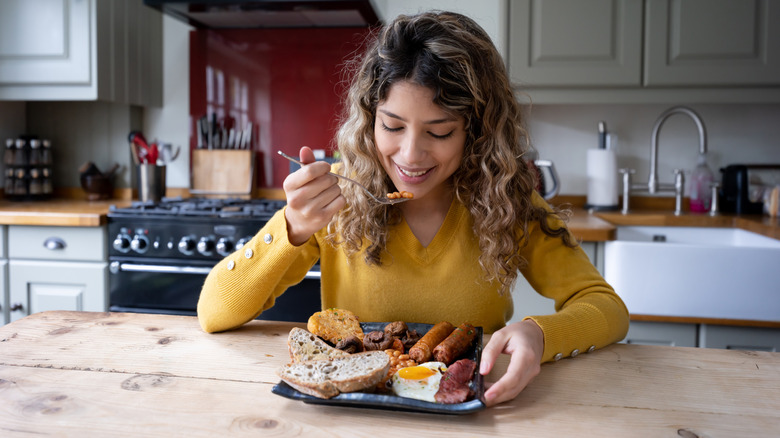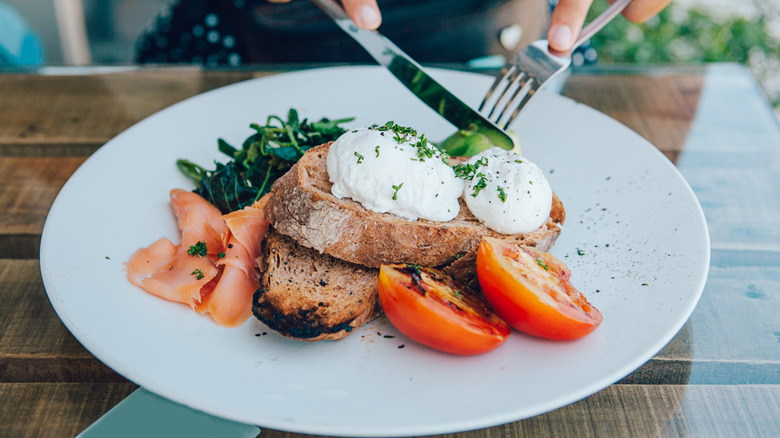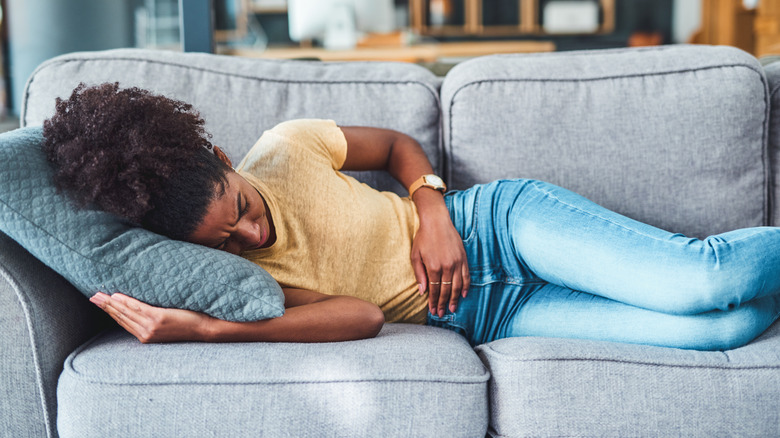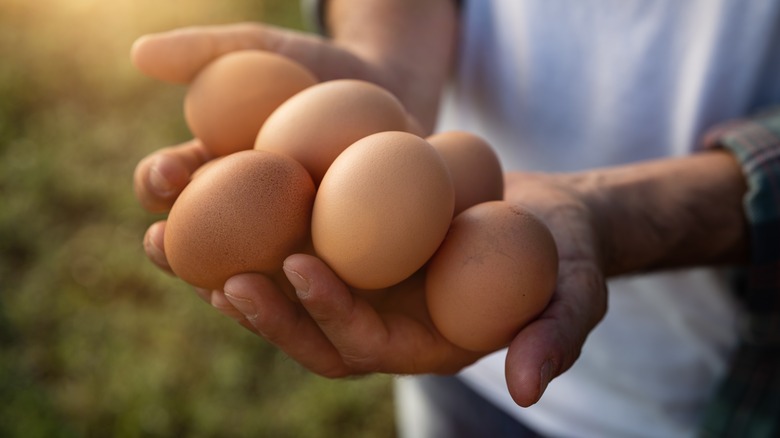Fried Eggs Vs Poached Eggs: Everything You Need To Know
Almost everyone loves a good egg every once in a while, but how everyone likes to enjoy those eggs is likely to be totally unique. There are so many ways to prepare eggs these days, but fried and poached eggs are arguably some of the tastiest and most satisfying options out there.
So, what's the difference between the two? Quite a bit, actually. Though poached eggs and fried eggs are delicious in their own right, they couldn't be any more different. In this article, we'll detail the differences between the two while giving you specific information concerning the preparation, taste, nutritional profile, and more of both. And in case you're wondering where we got our information from, just know that we went out of our way to conduct the research, gather online opinions, and consult home chefs to ensure we've got our facts straight. Oh, and we've also thrown a bit of our own experience in there as well! Without further ado, let's get crackin' with the details concerning everything you need to know about fried eggs vs. poached eggs.
What are fried eggs?
Fried eggs are eggs cooked in butter or oil over heat, usually in a skillet. This quintessential and very popular breakfast option comes in four distinct forms: sunny-sideup, over-easy, over-medium, and over-hard. While we won't get into the details about how to make each type of fried egg just yet (don't worry — we'll provide more information on this later in the article), we do at least want to mention that the phrase "over" in the several of types of fried egg mentioned refers to the fact these fried eggs are indeed flipped. The only variety not flipped is your sunny-side up version, which is also one of the "rawest" versions of fried egg you can eat since neither the egg yolk nor white is firmly set.
You can also expect that most fried eggs will not contain the whimsical toppings of your typical omelet, but instead will likely be topped with salt and pepper as traditional flavorings. It may sound boring, but these sorts of eggs pair well with meat and toast, and are often offered with fruit, veggies, or potatoes on the side to make things a little more interesting.
What are poached eggs?
Poached eggs are eggs that have been delicately cooked in a pot of hot water. Not to be confused with boiled eggs, the temperature of the water remains low comparatively and requires specific techniques to get the poached egg just right. Though cooking techniques for this dish vary, the overall cooking process will remain about the same. In addition, poached eggs will take on a unique shape, and will remain runny in the center with firm whites for a velvety rich flavor poached egg devotees can't resist.
Poached eggs can be eaten as is, but they also have many other uses beyond this. They can be eaten as a part of the American-favorite eggs Benedict dish or as part of a simpler entrée, but don't worry — we'll discuss the many ways to enjoy eggs of this sort later on.
Another thing to note is that, unlike the fried egg, there aren't many variations in terms of outcomes for poached eggs. This means that while fried eggs can come sunny-sideup, over easy, over medium, and over hard, you likely won't find your server or home chef asking you how you'd like your poached egg cooked. Still, if you're cooking your poached egg at home, you can intentionally overcook it a little for added firmness, if that is your desired result.
Origins
When it comes to the history of the fried egg, it's safe to say that people have been cooking (i.e., frying) eggs for many, many years. Ever since the initial domestication of chickens, which potentially started in China and Egypt, human civilization has reaped the benefits of eating cooked eggs. There's no doubt there were a variety of ways to cook up these eggs, naturally leading to the plethora of ways we relish them today.
With that said, we will admit that some methods aren't exactly the easiest or most commonplace way to cook eggs, with poached eggs being one of them. It is believed that poached eggs became popular in Europe around the 1800s and have been enjoyed ever since. Still, because of its specific technique and the amount of skill required, it isn't usually as commonly consumed as the humble fried egg. Nevertheless, avid enthusiasts love eggs cooked this way, and because of the velvety and deeply rich flavor they provide, we can't say we blame them!
Nutrition
As you might imagine, the actual nutritional content of your eggs will depend on a variety of factors. Everything from the type of egg you pick to the ingredients and even the cooking method can determine what the actual nutrition of both your fried egg and poached egg might look like.
In case you don't believe us, take fried eggs, for example. Though requiring minimal ingredients, the way you cook a fried egg can actually affect its nutritional makeup. According to Healthline, overcooking an egg or cooking it over high heat for long amounts of time may actually increase the oxidized cholesterol content in the eggs. On the flip side, the less amount of time you cook the egg, the more of the nutritional content may be retained, though you'll need to watch for the health risks associated with eating undercooked eggs as well.
In general, it should be said that poached eggs will generally be healthier than a fried egg for obvious reasons. Though a fried egg isn't likely to be particularly unhealthy for most folks, the absence of oil and butter when making poached eggs is what makes this particular egg-cooking technique preferable in terms of health.
Ingredients
Both poached eggs and fried eggs contain minimal ingredients, but how you dress them up is totally up to you. We'll go into more details about the uses of poached and fried eggs in common recipes later on, but for now, we'll at least say that the ingredients normally involved in poached and fried eggs don't tend to get very complicated.
Starting with fried eggs, feel free to cook them either in oil or butter. Butter will render more flavor, while oil will lend itself to the crispiest results. In addition, you'll typically finish off your fried egg with a bit of salt and pepper. Though this step is optional, with some preferring one type of seasoning over another — or even none at all!
Poached eggs, on the other hand, will not require oil or butter but, instead, a pot of water with your choice of ingredients (depending on the intended result). Adding vinegar or salt to the hot water is optional. However, we'll dive deeper into the methods we think are best once we detail the cooking process for poached eggs later. For now, just know that at the most basic level, a poached egg requires only an egg, water, and optional salt and pepper for seasoning afterward. Easy!
Equipment needed
Thankfully, it's relatively easy to gather the equipment you'll need for both poached and fried eggs. For fried eggs, you'll simply need a good frying pan. The shape and makeup of a frying pan are important as this allows the surface of the pan to heat quickly for a good and crisp fry. Frying pans come in a variety of options, from stainless steel to non-stick. You can even fry an egg in a cast iron skillet, though you'll want to use a little extra oil in most cases to prevent sticking.
As for poached eggs, all you really need is a pot large enough for poaching the amount of eggs you want along with a large, slotted spoon and a strainer. If you want to get fancy (and for best results, we recommend you do), you may want to grab a few ramekins for each egg you intend to poach. You'll see in later segments why these ramekins are important, but for now, remember that though not a necessity, these are pieces of "equipment" for making poached eggs that are nice to have.
Oh, and one last thing. When it comes to making poached eggs, the presentation of the egg is often as important as the taste itself. To clear away any excess "wispies", consider adding kitchen shears as part of your arsenal. This will enable you to quickly cut away the excess without butchering your perfectly poached egg in the process.
Cooking process
Now for the fun part — how to make fried and poached eggs! Starting with fried, sunny-side up eggs requires you to cook them until egg whites are set (but barely), and the yolk is still runny. Do not flip. For over-easy eggs, cook until the whites are set before flipping and cooking another 20 seconds or so — the yolks will remain runny. Over-medium eggs have the oh-so-delicious "jammy" inside, so the yolk isn't quite runny. For this effect, you'll cook the eggs similar to the way you would over easy, but this time, you'll flip the egg and cook for one additional minute. Lastly, over-hard eggs are cooked and flipped until the yolks are no longer runny and the whites are firmly set.
For poached eggs, the process is a bit more intense. For the perfect poached egg, we recommend you use the freshest eggs possible, skip salting the water, and instead add a bit of vinegar. Heat your pot of water to boiling before shutting off the heat. Once the bubbles in the water have stopped breaking at the surface, crack your eggs individually over a strainer. Pour the remaining egg from your strainer into individual ramekins. With your spoon, stir the water in a circular motion to create a "whirlpool". Drop each egg into the center of the whirlpool one at a time, and let cook for 3 minutes before fishing them out with a slotted spoon. Carefully trim away any wisps with kitchen shears.
Difficulty
The level of difficulty in making fried and poached eggs will vary. When it comes to fried eggs, the difficulty level will depend on the type of fried egg you choose. You'll need to pay close attention to timing to really get this down to a science. As mentioned earlier in the cooking process segment of this article, each type of fried egg requires different timings and methods. While the over-hard is by far the easiest, other methods, like sunny-side up, over-easy, and even over-medium, will require a bit of finesse to get it just right.
Even with this in mind, we think poaching eggs is more difficult than any type of fried egg process. The reason? The process of poaching eggs is very finicky and requires time, patience, and skill. Poached eggs at home often turn out gnarly and unattractive, so certain techniques are needed to make them worthwhile. The addition of vinegar, straining, dumping each egg in a ramekin, and adding them to the center of a water whirlpool all make a difference when it comes to how to achieve a perfectly cooked poached egg. Timing also matters, and a quick clip of kitchen shears when needed helps, proving that this cooking method is a bit higher maintenance than most frying methods — but it is still very worth it!
Taste
As far as taste is concerned, we think it's safe to say that fried eggs may be the most flavorful when compared to poached eggs. Still, it's important to bear in mind that this difference in flavor does not necessarily denote the fried egg as better.
Yes, fried eggs may be tastier given the fact that they are potentially cooked in butter or oil with seasoning, but a fried egg doesn't hold a candle to the soft and velvety texture of a poached egg. For some, texture and appearance go a long way, and, when done correctly, the poached egg gives us all of that and then some. After all, let's not forget how delicious eggs are on their own; they don't necessarily need butter or oil to give that deeply satisfying umami flavor. Poached eggs then may be classified as best for egg purists — those who truly love the rich and flavorful essence of the egg itself, rather than focusing on oil or butter to amplify its savor.
Uses
Now that you know cooking techniques for making the perfect fried and poached eggs, it is now time to discuss how to put your newfound skills to use. Though it's completely acceptable to devour fried and poached eggs on their lonesome, it is far more delightful to enjoy each with something tasty; but don't worry, we've got plenty of advice!
Starting with the fried egg, consider adding this rich and flavorful addition to plates that are already full of umami flavor. An egg is a common addition to ramen, so adding one that is fried is a brilliant way to amplify the flavors of ramen easily and affordably. Another great way to enjoy fried egg is to simply layer it over toast. Add this with other fixings (like mashed avocado), and you'll have a breakfast worth waking up for.
Poached eggs also have a variety of uses with the most notable being eggs Benedict. This hollandaise-smothered breakfast usually consists of Canadian bacon, an English muffin, and a poached egg. People tend to truly love eggs Benedict, but it certainly isn't the only recipe that utilizes poached eggs. Try this type of egg over salads, rice, asparagus, or even spinach. These are tasty, easy, and healthy options you can enjoy for breakfast, lunch, and dinner. We love it!
Safety
Although eating both poached and fried eggs is indeed delicious, there are risks to enjoying both types that are dependent upon how they are cooked. Poached, sunny-side up, and over-easy eggs are the most common culprits of undercooked eggs in this context, and you'll want to consider whether or not it's worth the risk before you consume them. The biggest issue regarding the consumption of undercooked eggs is the risk of Salmonella, which can yield unsavory effects on your health when eaten unpasteurized (via the CDC). In addition, exposing children younger than 5 years old to runny yolks is also very dangerous, and thus, it isn't recommended that your little one eat eggs prepared this way, regardless of how yummy it tastes (via University of Minnesota Extension).
With this said, there seems to be a difference in whether you use pasteurized eggs or fresh when making fried or poached eggs. If the eggs you purchase are pasteurized, it may be safe to consume the eggs sunny-side up, over-easy, poached, or even raw if you choose. Because the eggs have been heated with the shell still intact, this set temperature pasteurization process works to destroy the potentially dangerous bacteria within the egg, and thus, doesn't pose the same risks to your health that a fresh egg would (via USDA). Just do your research and choose wisely — your health depends on it!
Methodology
The information needed to compare fried eggs to poached eggs was gathered from our own experience, as well as from home chefs and high authority sources. After reviewing several recipes and comparing the differences in preparation between them, we were able to compose this informative article to help keep you in the know concerning all the details you've ever wanted about fried and poached eggs.
